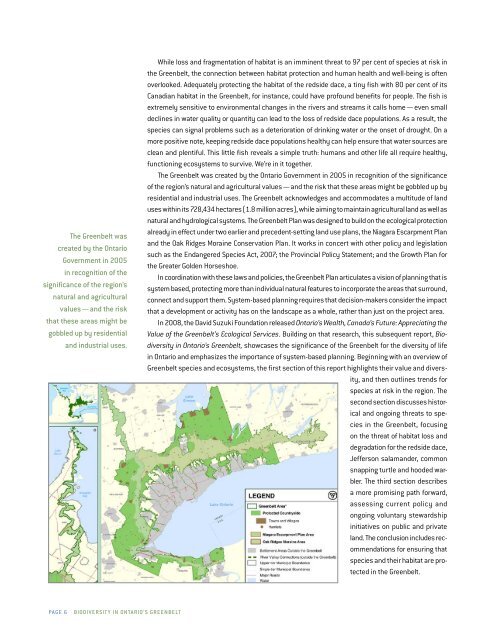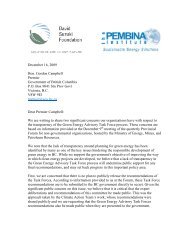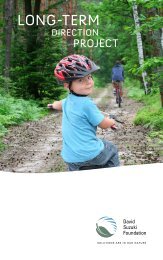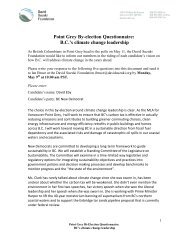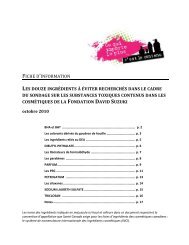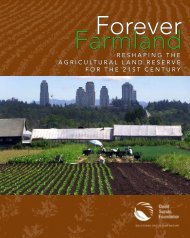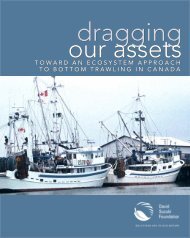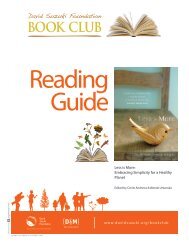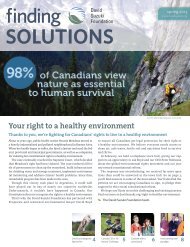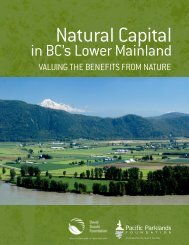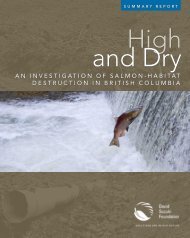Biodiversity in Ontario's Greenbelt (PDF) - David Suzuki Foundation
Biodiversity in Ontario's Greenbelt (PDF) - David Suzuki Foundation
Biodiversity in Ontario's Greenbelt (PDF) - David Suzuki Foundation
Create successful ePaper yourself
Turn your PDF publications into a flip-book with our unique Google optimized e-Paper software.
The <strong>Greenbelt</strong> was<br />
created by the Ontario<br />
Government <strong>in</strong> 2005<br />
<strong>in</strong> recognition of the<br />
significance of the region’s<br />
natural and agricultural<br />
values — and the risk<br />
that these areas might be<br />
gobbled up by residential<br />
and <strong>in</strong>dustrial uses.<br />
While loss and fragmentation of habitat is an imm<strong>in</strong>ent threat to 97 per cent of species at risk <strong>in</strong><br />
the <strong>Greenbelt</strong>, the connection between habitat protection and human health and well-be<strong>in</strong>g is often<br />
overlooked. Adequately protect<strong>in</strong>g the habitat of the redside dace, a t<strong>in</strong>y fish with 80 per cent of its<br />
Canadian habitat <strong>in</strong> the <strong>Greenbelt</strong>, for <strong>in</strong>stance, could have profound benefits for people. The fish is<br />
extremely sensitive to environmental changes <strong>in</strong> the rivers and streams it calls home — even small<br />
decl<strong>in</strong>es <strong>in</strong> water quality or quantity can lead to the loss of redside dace populations. As a result, the<br />
species can signal problems such as a deterioration of dr<strong>in</strong>k<strong>in</strong>g water or the onset of drought. On a<br />
more positive note, keep<strong>in</strong>g redside dace populations healthy can help ensure that water sources are<br />
clean and plentiful. This little fish reveals a simple truth: humans and other life all require healthy,<br />
function<strong>in</strong>g ecosystems to survive. We’re <strong>in</strong> it together.<br />
The <strong>Greenbelt</strong> was created by the Ontario Government <strong>in</strong> 2005 <strong>in</strong> recognition of the significance<br />
of the region’s natural and agricultural values — and the risk that these areas might be gobbled up by<br />
residential and <strong>in</strong>dustrial uses. The <strong>Greenbelt</strong> acknowledges and accommodates a multitude of land<br />
uses with<strong>in</strong> its 728,434 hectares (1.8 million acres), while aim<strong>in</strong>g to ma<strong>in</strong>ta<strong>in</strong> agricultural land as well as<br />
natural and hydrological systems. The <strong>Greenbelt</strong> Plan was designed to build on the ecological protection<br />
already <strong>in</strong> effect under two earlier and precedent-sett<strong>in</strong>g land use plans, the Niagara Escarpment Plan<br />
and the Oak Ridges Mora<strong>in</strong>e Conservation Plan. It works <strong>in</strong> concert with other policy and legislation<br />
such as the Endangered Species Act, 2007; the Prov<strong>in</strong>cial Policy Statement; and the Growth Plan for<br />
the Greater Golden Horseshoe.<br />
In coord<strong>in</strong>ation with these laws and policies, the <strong>Greenbelt</strong> Plan articulates a vision of plann<strong>in</strong>g that is<br />
system based, protect<strong>in</strong>g more than <strong>in</strong>dividual natural features to <strong>in</strong>corporate the areas that surround,<br />
connect and support them. System-based plann<strong>in</strong>g requires that decision-makers consider the impact<br />
that a development or activity has on the landscape as a whole, rather than just on the project area.<br />
In 2008, the <strong>David</strong> <strong>Suzuki</strong> <strong>Foundation</strong> released Ontario’s Wealth, Canada’s Future: Appreciat<strong>in</strong>g the<br />
Value of the <strong>Greenbelt</strong>’s Ecological Services. Build<strong>in</strong>g on that research, this subsequent report, <strong>Biodiversity</strong><br />
<strong>in</strong> Ontario’s <strong>Greenbelt</strong>, showcases the significance of the <strong>Greenbelt</strong> for the diversity of life<br />
<strong>in</strong> Ontario and emphasizes the importance of system-based plann<strong>in</strong>g. Beg<strong>in</strong>n<strong>in</strong>g with an overview of<br />
<strong>Greenbelt</strong> species and ecosystems, the first section of this report highlights their value and diversity,<br />
and then outl<strong>in</strong>es trends for<br />
species at risk <strong>in</strong> the region. The<br />
second section discusses historical<br />
and ongo<strong>in</strong>g threats to species<br />
<strong>in</strong> the <strong>Greenbelt</strong>, focus<strong>in</strong>g<br />
on the threat of habitat loss and<br />
degradation for the redside dace,<br />
Jefferson salamander, common<br />
snapp<strong>in</strong>g turtle and hooded warbler.<br />
The third section describes<br />
a more promis<strong>in</strong>g path forward,<br />
assess<strong>in</strong>g current policy and<br />
ongo<strong>in</strong>g voluntary stewardship<br />
<strong>in</strong>itiatives on public and private<br />
land. The conclusion <strong>in</strong>cludes recommendations<br />
for ensur<strong>in</strong>g that<br />
species and their habitat are protected<br />
<strong>in</strong> the <strong>Greenbelt</strong>.<br />
Page 6<br />
<strong>Biodiversity</strong> <strong>in</strong> Ontario’s greenbelt


